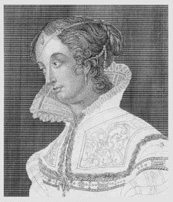The Good, the Bad and the Unready (19 page)
Read The Good, the Bad and the Unready Online
Authors: Robert Easton

 Fair Rosamund
Fair Rosamund
Rosamund Clifford, mistress of King Henry II of England, c.1140–c.1176
Legend tells us that Henry
CURTMANTLE
was besotted with the ravishing Rosamund and kept her prisoner in a maze in Woodstock near Oxford. Legend similarly states that Eleanor of Aquitaine, Henry’s wife, was beside herself with jealousy and that she mastered the maze and offered Rosamund two equally unappealing options: death by dagger or death by poison. This is codswallop. As the historian Giraldus Cambrensis, among others, makes clear, Henry lived openly with the beautiful Rosamund, while the dumped Eleanor lived under a form of house arrest.

Fair Rosamund
 Harold
Harold
Fairhair
Harold, king of Norway, c.860–c.940
Stung by the rejection of the princess of a neighbouring country to his romantic advances, Harold vowed not even to comb, let alone cut, his hair until he became the sole ruler of Norway. For ten long years Harold battled against other local, petty kings for national supremacy, and for ten long years his hairstyle alarmed all and sundry. But then, in 872, Harold won a famous victory at Hafrs Fjord and seized control of the entire nation. After what must have been a dramatic wash and set, the new-look Harold so delighted his subjects with his clean flowing locks that they instantly changed their nickname for him from ‘Shockhead’ to ‘Fairhair’.
 Denis the
Denis the
Farmer
see
NOBLE PROFESSIONS
 Farmer George
Farmer George
George III, king of England, 1738–1820
An avid interest in botany and agriculture earned George his nickname but also the disapproval of many of his senior officials, who grumbled that he preferred country pursuits to politics. Certainly George did not like city life, preferring cricket and flying kites to court functions and the theatre. He was in fact one of the first London commuters, regularly galloping twenty miles back to rural Windsor after eating a hasty supper at St James’s Palace. There he would pen articles for the scholarly periodical
Annals of Agriculture
and prepare parliamentary speeches on diseases among horned cattle.
In his later years George used a lathe to make a set of ivory buttons, for which some dubbed him ‘the Button-Maker’, but most people today remember him for the last years of his life when he was intermittently mad. Anecdotes from this period abound. In a particularly popular story, he was said to have got out of his coach in Windsor Great Park and – in a notable lapse of botanical know-how – shook hands with an oak tree because he was under the impression it was Frederick the
GREAT
.
 Charles the
Charles the
Fat
Charles III, Frankish king and Holy Roman Emperor, 839–88
Incongruously, the vastly overweight Charles was known during his own lifetime as ‘Karoleto’ or ‘Little Charles’ to distinguish him from Charles the
BALD
. It was not until some four centuries later that he received his more common epithet of ‘the Fat’. Obesity, however, was not his most pressing medical condition.
Charles suffered from a debilitating illness that exhibited itself in regular savage headaches and the occasional spectacular seizure. His condition made it virtually impossible for him to
rule, and so in early 887 the emperor underwent a surgical skull incision – a trepanation – in the hope that this might bring relief. If it did, it was temporary. Charles died the following year while in exile in Swabia.
 Henry the
Henry the
Fat
Henry I, king of Navarre, c.1210–74
After a four-year reign, marked, it is said, by dignity and diplomacy, ‘Enrique el Gordo’, or ‘Henri le Gros’, died. According to most of the received accounts, this youngest son of Theobald the
TROUBADOUR
(
see
NOBLE PROFESSIONS
) suffocated on his own fat.
 Louis the
Louis the
Fat
Louis VI, king of France, 1081–1137
Philip the
AMOROUS
, Louis’s father, was so overweight that he was forced to hand over the day-to-day administration of the kingdom to his comparatively trim son. But Louis was no slouch in the obesity stakes either. Predisposed to both gluttony and corpulence, he was so fat that after the age of forty-six any horse that he sat on simply buckled.
In his account of the deeds of Louis, the abbot and historian Suger wrote that in 1126 his body was so ‘weighed down by burdensome folds of flesh’ that ‘no-one, not even a beggar, would have wanted or been able to ride a horse when hampered by such a dangerously large body’ Presumably the horse would have had similar objections.
 Sancho the
Sancho the
Fat
Sancho I, king of Castile and Leon, d.967
When Sancho came to the throne in 956 he was so fat that he could hardly walk, let alone ride a horse. As such, he could only sit and, with difficulty, raise a finger in protest as rebels under
his cousin Ordono stormed the palace and forced him into exile. A few years of dieting later, however, and Sancho was back. The new, improved and slender Sancho marched on León with a large Muslim army and successfully recovered his kingdom.